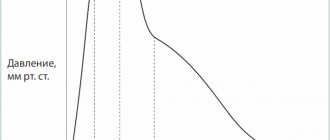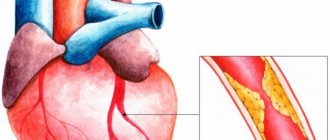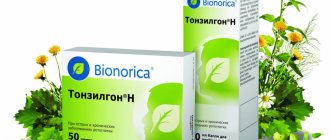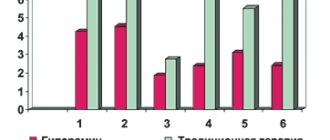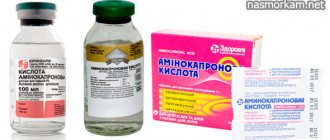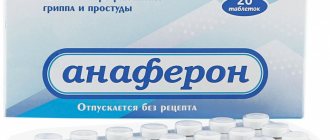Pharmacodynamics and pharmacokinetics
The active substance stimulates the process of increasing the concentration of cGMP , which, in turn, relaxes vascular smooth muscle cells . Thus, the preload and the body's need for oxygen are reduced. Vasodilation occurs in the heart muscle. Blood circulation improves, cardiac endurance increases, and the number of angina .
Blood clotting is reduced due to the ability of molsidomine to suppress the early phase of platelet aggregation . If chronic heart failure occurs, then the drug has the ability to reduce the size of the heart chambers, tension in the myocardium , and the amount of blood in the left ventricle.
After oral administration, the medicine is absorbed within half an hour, and with sublingual administration – after 10 minutes. The product reaches its maximum effect after half an hour - an hour, this state lasts 6 hours. Metabolism occurs in the liver and is excreted through the kidneys.
Pharmacological properties of the drug Sydnopharm
Pharmacodynamics. The drug has an antianginal effect. It has a beneficial effect on preload and myocardial metabolism, as a result of which the need for oxygen is sharply reduced. In the body it is spontaneously biotransformed into the active metabolite CIN-1A, which has a pronounced vasodilating effect, primarily on capacitive venous vessels. Increases the diameter of subendocardial vessels, improves coronary circulation and oxygen supply to the myocardium, which in turn increases the exercise tolerance of patients with coronary artery disease. Molsidomine is an NO donor. It activates guanylate cyclase and increases the intracellular concentration of cGMP. Pharmacokinetics. The maximum concentration in the blood serum is 4.4 mcg/ml, the time to reach the maximum concentration is on average 1 hour. Metabolism is intensive (metabolized into CIN-1/3-morpholinosidnonimine, which through spontaneous biotransformation turns into the pharmacologically active CIN-1A); half-life - 3.5 hours; eliminated in the form of metabolites (almost the entire amount of CIN-1A is excreted in the urine throughout the day).
Indications for use of Sidnopharm
The drug is prescribed for the prevention and treatment (relief) of angina attacks:
- for chronic heart failure (in combination with other drugs);
- with acute left ventricular failure;
- with hypertrophy of the right ventricle due to diseases that interfere with the normal functioning of the lungs;
- with increased pressure in the pulmonary circulation .
Also, an indication for the use of Sidnofarm is myocardial infarction (but only when hemodynamic parameters have stabilized).
Contraindications
The drug should not be taken:
- during the acute period (!) of myocardial infarction (especially against the background of low blood pressure);
- glaucoma;
- drug allergies to components;
- low blood pressure (below 100 Hg);
- cardiogenic shock;
- in old age;
- with vascular collapse ;
- with toxic pulmonary edema ;
- for circulatory disorders in the brain.
The medicine is not prescribed to pregnant and lactating women, in combination with Sildenafil , or to children under 18 years of age.
Particular caution should be exercised if you are prone to low blood pressure after a hemorrhagic stroke .
Special instructions for the use of the drug Sydnopharm
Particular attention when treating with the drug is required for patients after hemorrhagic stroke, with cerebrovascular accidents and increased intracranial pressure, recent myocardial infarction, patients with glaucoma and a tendency to hypotensive reactions or in the presence of hypotension. For elderly patients with functional liver or kidney failure, the drug is prescribed in lower doses. Each dose contains up to 0.06 g of lactose. Due to the presence of wheat starch in the drug, Sidnopharm should be prescribed with caution to patients with celiac disease (gluten enteropathy). During pregnancy and breastfeeding. During pregnancy (after the first trimester), comprehensive consideration of indicators and the ratio of benefits to the mother and potential risk to the fetus is required. During breastfeeding, it is recommended to stop using the drug. If this is not possible, breastfeeding should be stopped during treatment. The drug is not used in children. Considering the side effects of the drug and the possible negative impact on the concentration of people driving vehicles or working with automated mechanisms, the drug is prescribed with caution after a thorough assessment of the likely risk.
Side effects
There is a high probability of a decrease in blood pressure , tachycardia , facial flushing, vascular collapse , nausea, anorexia , and general weakness. Allergic reactions may occur .
Sometimes headache, dizziness, nausea and vomiting may occur at the beginning of treatment, but these effects disappear after a while.
Sidnopharm, instructions for use (Method and dosage)
The tablets are taken orally or sublingually (if necessary) during meals or after meals.
The regimen and dosage should be prescribed by a doctor, depending on the frequency of attacks and the nature of the disease. The duration of administration should also be determined by the attending physician.
According to the instructions for use of Sidnopharm, the maximum daily dosage is 12 mg of the drug. As a preventative measure, for the first few days, half or a whole tablet is prescribed four to six times a day. Further, the daily dosage can be increased to 8 mg, distributing it into 2-3 doses.
In acute cases of the disease, as a rule, the dosage is increased to 4 tablets in 3-4 doses.
Sydnopharm
Sidnopharm (active ingredient molsidomine) is a peripheral vasodilator from the sydnonimine group. The drug increases the lumen of the peripheral vessels of the venous bed, has an antiplatelet, analgesic and antianginal (anti-ischemic) effect.
Coronary heart disease (CHD) is manifested by impaired blood supply to the heart muscle due to damage to the coronary arteries of the heart. In Russia, about 1 million people die annually from cardiovascular pathology, which is not only alarming, but forces cardiologists to sound the preventive alarm bell due to such a high rate of cardiovascular mortality. Angina pectoris is one of the most obvious signs of coronary artery disease. Its treatment involves influencing certain pathogenetic links of IHD using certain groups of drugs. IHD develops under conditions of an imbalance between the actual supply of oxygen to the myocardium and its urgent need for it. The main goal of treatment of coronary artery disease is to reduce the frequency of angina events until their complete elimination. This gives the patient the opportunity to remain active and not feel the discomfort of life. It is widely known that an attack of angina can be stopped with nitroglycerin and other drugs from the nitrate group. Much fewer people (except, of course, doctors) know that today there is a completely adequate alternative to nitrates - sydnonimines, the most typical representative of which is the Bulgarian drug sydnopharm. Not being a nitrate in its chemical structure, sydnopharm has a similar effect to them, because is able to “bite off” a nitric oxide molecule from itself. When introduced into the body, the drug undergoes metabolic transformations in the liver, after which it enters the blood and cleaves off the NO group, which, in turn, activates the enzyme guanylate cyclase. As a result, the concentration of cyclic guanosine monophosphate increases, which relaxes the smooth muscle framework of the choroid and dilates blood vessels.
Thus, the vasodilatory effect of sydnofarm is similar to the action of endothelial relaxing factor. In the venous bed, the drug dilates mostly medium and small blood vessels, thereby reducing blood flow and preload on the heart. Due to some features of its action, tolerance does not develop to sidnopharm, unlike the same nitrates (addiction and reduction of the pharmacological effect). While taking the drug, the resistance of the coronary arteries decreases and blood flow in the myocardium increases, which improves blood supply to its ischemic areas without the development of steal syndrome. Sidnopharm suppresses the aggregation (sticking together) of platelets, inhibits the synthesis of thromboxane (a mediator of platelet aggregation), prevents the adhesion (sticking) of platelets to the walls of blood vessels, increases the formation of prostacyclin, which also suppresses platelet aggregation and has a vasodilating effect. The active metabolite of the drug reduces left ventricular and blood pressure, reduces the systolic volume of the heart.
The effect of Sidnopharm begins to develop 15-20 minutes after administration and lasts from 1 to 6 hours (usually about 4). The dose and duration of the pharmacotherapeutic course are determined by the doctor individually. Food does not affect the absorption of the drug in the gastrointestinal tract. The tablets should be swallowed without chewing and washed down with water. The initial dose according to general recommendations is 1-2 mg 2 times a day. If there is no or insufficient therapeutic effect, the frequency of administration can be increased up to 3 times so that the daily dose does not exceed 6 mg. The drug is not intended to directly relieve angina attacks.
Reviews about Sydnopharm
The medicine has different reviews. The drug helps many people, their overall health improves, and the incidence of atrial fibrillation during physical activity. For some, the effect of the drug is insufficient, and they switch to taking other drugs. In any case, the issue of stopping or changing the medication should be decided with the attending physician, everything is purely individual.
Often, at the beginning of taking the drug, headaches and nausea appear, but after a week this effect disappears.
SYDNOPHARM – EFFECTIVE PREVENTION OF ANGINE ATTACKS
The medicine is not effective in stopping an attack of angina in the acute stage of development. When you first take Sidnofarm, you must carefully monitor your blood pressure to prevent it from decreasing too much, as well as severe headaches and loss of consciousness. If the functioning of the kidneys, liver, or a tendency to low blood pressure in elderly people is impaired, it is necessary to adjust the dose downward and strictly adhere to it.
The use of Sidnofarm excludes the use of alcohol . During the course of treatment (especially in the initial period), it is recommended to refrain from driving vehicles and work that requires concentration and speed of response. Constant monitoring is required during the use of the drug in patients with a heart attack, hemorrhagic stroke, cerebral circulatory disorders, glaucoma and a tendency to increase intracranial pressure, the presence of hypotension (low pressure). The wheat starch included in Sydnofarm contains gluten, but such a small amount is safe for people with celiac disease. Sikovit E110 dye can provoke an allergic reaction.
Cardiovascular disease is the leading cause of death worldwide, with more than 75% of deaths occurring in low- and middle-income countries. The most effective way to prevent CVD is a healthy lifestyle: outdoor sports, proper nutrition, giving up bad habits, etc. Coronary heart disease and stroke occupy the top two places in the mortality ranking. More than 75% of deaths from CVDs occur in low- and middle-income countries. These data were published in a report by the World Health Organization. According to WHO, the most common cause of heart attacks and strokes is the formation of fatty deposits on the inner walls of blood vessels that supply blood to the heart or brain. Currently, CVDs cause one in three deaths in the world, amounting to 17 million deaths per year. WHO predicts that the number of deaths from cardiovascular diseases will reach 25 million worldwide by 2022. According to WHO, people in low- and middle-income countries with CVD have less access to effective health services that meet their needs (including early detection services). As a result, many people die from CVDs at a younger age, often during the most productive years of life.
Sidnopharm price, where to buy
The price of Sidnopharm is about 137 rubles for 30 tablets of 2 mg.
- Online pharmacies in RussiaRussia
- Online pharmacies in UkraineUkraine
Pharmacy Dialogue
- Sidnopharm (2 mg tablet No. 30) Sopharma
RUB 232 order
show more
Pharmacy24
- Sydnopharm 2 mg No. 30 tablets PAT "Vitamin" Ukraine
90 UAH. order
